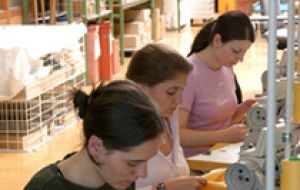MercoPress. South Atlantic News Agency
Employment and industrial production in Euro-zone confirm shrinking tendency
 Creating jobs remains the main challenge for the European Union
Creating jobs remains the main challenge for the European Union Employment in the Euro-zone shrank during the third quarter and October industrial production also contracted 0.6% on a month-on-month basis, according to the latest release from Eurostat, the European Community Statistics Office.
The number of persons employed in the 16-country Euro area fell by 0.5% (712 000 persons) in the third quarter of 2009 compared with the previous quarter, said Stat in the release. In the same period, the number of persons employed in the European Union (27 countries) also decreased by 0.5% (1.019.000 persons).
In the second quarter of 2009, employment declined by 0.5% in the Euro area and by 0.6% in the EU 27. These figures are seasonally adjusted.
According to Eurostat all sectors of the economy recorded a decrease in employment, except other services (which mainly includes public administration, health and education), which grew by 0.3% in the Euro area and by 0.2% in the EU27.
Decreases were recorded in construction (-2.0% and -1.9% respectively), manufacturing (-1.7% and -1.6%), agriculture (-1.1% and -0.4%), financial services & business activities (-0.5% and -0.4%) and trade, transport & communication services (-0.1% and -0.2%).
Compared with the same quarter of the previous year, employment fell by 2.1% in the Euro area and by 2.0% in the EU27 in the third quarter of 2009.
In the second quarter of 2009, employment decreased by 1.8% and 1.7% respectively.
Eurostat estimates that, in the third quarter of 2009, 221.6 million men and women were employed in the EU 27 of which 144.8 million were in the Euro area. These figures are seasonally adjusted.
Eurostat also points out that seasonally adjusted industrial production in the Euro area during October contracted 0.6% compared to September, and by 0.7% in the EU 27.However in September production increased by 0.2% and 0.1% respectively.
But in October 2009 compared with October 2008, industrial production declined by 11.1% in the Euro area and by 10.2% in the EU27.
A more detailed map by sectors shows that Oct.2009/Sept.2009 production of intermediate goods increased by 1.2% in the Euro area and by 0.8% in the EU 27. Capital goods remained stable in the Euro area but fell by 0.1% in the EU 27.
Energy production fell by 0.3% in both zones while durable consumer goods dropped by 1.4% and by 0.2%. Non-durable consumer goods decreased by 1.6% and 1.2% respectively.
Among the Member States for which data are available, industrial production rose in nine, fell in nine and remained stable in Estonia. The highest increases were registered in Finland (+2.2%), Bulgaria (+2.1%), the Netherlands and Poland (both +0.6%), and the largest falls in Slovenia (-3.2%), Ireland (-2.8%) and Germany (-1.8%).
On an annual basis, October 2009/0ct0ber 2008, production of non-durable consumer goods fell by 3.5% and by 2.9%. Production of energy decreased by 6.8% and 7.0%; intermediate goods declined by 12.4% and by 12.0%; durable consumer goods dropped by 14.9% and 12.4%; capital goods fell by 16.3% and by 15.2%.
Industrial production fell in all Member States for which data are available, except Ireland (+2.0%) and Poland (+1.1%). The largest decreases were registered in Estonia (-20.9%), Finland (-19.1%) and Slovenia (-18.4%), and the smallest in Romania (-1.4%), Portugal (-5.2%) and the Netherlands (-6.1%).




Top Comments
Disclaimer & comment rulesCommenting for this story is now closed.
If you have a Facebook account, become a fan and comment on our Facebook Page!